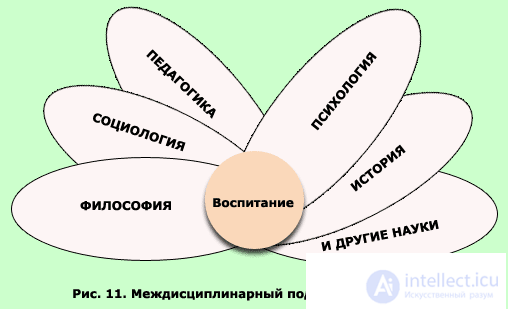Lecture
 The central category of scientific understanding of the educational process and professional pedagogical activity in the education of students is the concept of “education”. The category of education is one of the main ones in pedagogy and educational psychology. Much depends on how this concept is interpreted in the subsequent analysis and understanding of the essence of the phenomenon hidden behind this term. Therefore, we turn first to the terminological consideration (Parkinson, KN, et al., 1992; see annotation).
The central category of scientific understanding of the educational process and professional pedagogical activity in the education of students is the concept of “education”. The category of education is one of the main ones in pedagogy and educational psychology. Much depends on how this concept is interpreted in the subsequent analysis and understanding of the essence of the phenomenon hidden behind this term. Therefore, we turn first to the terminological consideration (Parkinson, KN, et al., 1992; see annotation).
The original meaning of the word "education" is due to the root part of the word: "education" is feeding, feeding a child who is not adapted to life and completely helpless at birth. In this sense of the word, the process of education is also peculiar to animals - mammals “feed” their milk.
Today, the term "education" is far from its original meaning, however, it is impossible not to admit that the reliance on the semantic source still persists. "Nutrition", in its direct meaning, ensures the growth and functioning of the body. “Nutrition”, in its figurative sense, means the socialization of a small child, his entry into culture and the “assimilation” of what is produced by culture.
Education is often interpreted in an even more local sense - as the solution of a particular educational task (for example, education of social activity, collectivism).

 The central concept of "education" has a whole fan of pedagogical terms denoting phenomena lying side by side or closely related to education. Among such concepts, first of all, it is necessary to single out: formation, formation, socialization (Fig. 2) (Asmolov AG, 2002; see annotation).
The central concept of "education" has a whole fan of pedagogical terms denoting phenomena lying side by side or closely related to education. Among such concepts, first of all, it is necessary to single out: formation, formation, socialization (Fig. 2) (Asmolov AG, 2002; see annotation).
First of all, we note “becoming” - a term reflecting a conditional achievement of a child of such a level of development when he becomes able to live independently in society, control his own destiny and independently build his behavior, and also has the ability to recognize his relationship with the world and produce relatively stable value choice .
 To say that a person has finally taken place is as impossible as it is impossible to imagine a frozen process that has accepted its final version, because the dynamics of life and the tortuous course of events will influence a person until his death. And this means that there is a need for another concept, broader and more flexible, which would reflect the infinity of personality change under the influence of the entire sum of vital and social factors. Such a concept is "formation." Personality formation is the process of personality change during its interaction with reality, the emergence of physical and socio-psychological tumors in the personality structure (Bozhovich LI, 1997; see abstract) (see Chrestomat. 10.1) (http: // www .ipd.ru /).
To say that a person has finally taken place is as impossible as it is impossible to imagine a frozen process that has accepted its final version, because the dynamics of life and the tortuous course of events will influence a person until his death. And this means that there is a need for another concept, broader and more flexible, which would reflect the infinity of personality change under the influence of the entire sum of vital and social factors. Such a concept is "formation." Personality formation is the process of personality change during its interaction with reality, the emergence of physical and socio-psychological tumors in the personality structure (Bozhovich LI, 1997; see abstract) (see Chrestomat. 10.1) (http: // www .ipd.ru /).
Physical, mental and social development of the individual is carried out under the influence of external and internal, social and natural, controlled and uncontrollable factors (see Fig. 3) (Biological ..., 1977; see annotation). It goes on in the process of socialization - the assimilation by a person of the values, norms, attitudes, patterns of behavior inherent in a given society, social community, group, and the reproduction of social ties and social experience . Socialization takes place both under conditions of a spontaneous influence on a developing person by factors of social being (in fact, rather contradictory), and under the influence of socially controlled conditions in the process of education (Fig. 4). The process and result of human development under the influence of heredity, environment, and upbringing in pedagogy is commonly called the formation of personality (see Khrest. 10.2).
Ability to develop is the most important property of a person throughout a person’s life. At the same time, the traditional point of view was that education is carried out only in relation to the younger generations. Only in the XX century. Began to actively develop the problem of adult education, which is reflected in the emergence of a special branch of pedagogical knowledge - andragogy.
Education, being part of the socialization of the individual, is carried out through the education and organization of the life activity of the communities of the educated. Education includes education, i.e. propaganda and dissemination of culture, which implies a high level of selectivity of subjects in the selection and assimilation of certain knowledge, and training. The organization of life takes place in organizations and groups that create conditions for the participation of subjects in various activities - cognitive, practical, spiritual, practical, communicative, gaming, sports. A special role in education is played by art, which reflects in emotionally-shaped form various types of social activity and develops the ability of a person to creatively transform the world around him and himself. Naturally, the systematicity, intensity, character, content, forms and methods of education and organization of life directly depend on the age, ethnocultural and socio-professional affiliation of the people educated, on the specifics of educational systems in different countries (SD Polyakov, 1996; see summary ),
(http://www.pirao.ru/strukt/lab_gr/g-fak.html; see the group of research factors of personality formation).
 Personality - one of the basic categories of psychological science. In order to understand what a person is and to identify the main properties that allow one to describe the mental profile of a person, it is necessary to consider this concept in the series "individual - subject of activity - personality - individuality" proposed by B.G. Ananyev (Ananyev B.G., 2001). The initial distinction between these concepts can be made as follows (Fig. 5, Fig. 6).
Personality - one of the basic categories of psychological science. In order to understand what a person is and to identify the main properties that allow one to describe the mental profile of a person, it is necessary to consider this concept in the series "individual - subject of activity - personality - individuality" proposed by B.G. Ananyev (Ananyev B.G., 2001). The initial distinction between these concepts can be made as follows (Fig. 5, Fig. 6).
An individual is a person as a typical representative of his own kind, a carrier of typical, naturally determined properties. In this case, the conditionality of human behavior is emphasized by genetic, metabolic, neurodynamic, and constitutional factors. Together, they cause the emergence of an integrative mental mechanism of temperament, which, in turn, is realized (manifested) in behavior.

The subject of activity is a person as a typical carrier of types of human activity; this is a person as a carrier of consciousness, mental mechanisms that regulate specifically human forms of activity.
A person is a person as a typical representative of the society that formed him, the society . It is revealed in the conditionality of his communication with other people and nature, the structure of his value orientations, the spectrum of his roles, the ratio of his rights and duties, etc. (Chrest. 10.3) (http://www.voppsy.ru/journals_all/issues/1995/952/952005.htm; see the article by Orlov AB “Personality and Essence: External and Internal I am Human”).
Individuality is a person characterized in the aspect of his uniqueness, uniqueness, dissimilarity to other people (Gurevich KM, 1998; see annotation) (see Khrest. 10.4).
In accordance with this four-aspect model of the psyche of B.G. Ananyev V.I. Ginetsinsky allocates a system of human properties (Ginetsinsky VI, 1997) (Fig. 7)
(http://www.pirao.ru/strukt/lab_gr/l-teor-exp.html; see the laboratory of theoretical and experimental problems of the personality psychology of the PI RAO),
(http://www.psy.msu.ru/about/lab/ht.html; see the Center for Psychological and Vocational Guidance Testing “Humanitarian Technologies”).
Discussion problem of the goals of education, having a specific historical character. Real goals are always specific not only for a particular epoch, but also for specific social systems, as well as specific institutions.
None of the existing numerous definitions of the purpose of education is exhaustive.
An interesting approach to determining the categories of educational goals in the affective area was proposed by P. Bloom (Fig. 8).
Often, taking into account aspects of the educational process, they call (in various combinations) ideological, political, military-patriotic, patriotic, moral, international, aesthetic, labor, physical, legal, sexual, environmental, economic education. There are concepts of pragmatic, civil, value, collectivist, communicative education, etc. On an institutional basis, distinguish family education, school, out-of-school, confessional (religious), as well as education in children's and youth organizations, by place of residence (communal in American pedagogy), in closed and special educational institutions (Miniyarov VM, 2000; see annotation).
According to the dominant principles and style of relations between educators and educators, authoritarian, free, democratic education is distinguished.
Being a complex social phenomenon, education is the object of study of a number of sciences (Fig. 11, Fig. 12).

Philosophy explores the cognitive, axiological, sociopolitical, moral and aesthetic attitude of the person to the world, the ontological and epistemological foundations of education; formulates the most general ideas about higher goals and values of education, in accordance with which its specific means are determined.
Sociology studies the social problems of personal development, the social "order" of the educational system, defined by society in an implicit form and formed by the state in documents, the conditions of implementation, regional and socio-cultural features of education, the system of educational institutions, institutions, the proportion and proportion of non-programmable social phenomena and targeted impact on the person in the process of socialization and education.
Ethnography examines the patterns of education among the peoples of the world at different stages of historical development, the normative canon of a person existing in different nations and his influence on education; nature of parental feelings, roles and relationships, etc.
Economic science determines the role in the growth of social production efficiency, financial and material and technical resources necessary for the optimal infrastructure of the educational system.
Jurisprudence deals with the legal forms of the organization and functioning of education; legal norms regulating the status, rights and obligations of the state, its institutions and citizens in the field of education.
Criminology , studying crime, incl. as the costs of socialization and education, develops measures for its prevention.
Biology, physiology, genetics explores the natural basis of development, affecting the process and results of education.
Pedagogy explores the essence of education, its laws, trends and development prospects; develops the theory and methodology of education, defining its principles, content, forms and methods.
Psychology reveals the individual, age, group characteristics and patterns of development and behavior of people, creating objective and subjective prerequisites for the effectiveness of methods and means of education. Much attention is paid to education so-called. confessional psychology, developed in order to form religious consciousness and behavior (http://www.psy.msu.ru/about/kaf/razvit.html).
First of all, it should be noted that there are no unambiguous solutions to the problem of determining criteria and indicators of upbringing levels. Approaches of researchers are different not only in the definition of certain criteria, indicators, but also in determining the essential features of these concepts.
IN AND. Zhuravlev, for example, defines criteria as scientifically grounded standards, which establish the degree of progress achieved in the development, formation, training, education of students. And the indicators are like phenomena that characterize the level of personal development, their training, upbringing, observed visually and setting a measure of the implementation in practice of the skills and skills of behavior and knowledge developed at schoolchildren.
In the “Big Encyclopedic Dictionary”, the criterion is defined as “the sign on the basis of which the assessment, determination or classification of something is made; the measure of evaluation” (Bolshoi ..., 1998, P.595).
The criterion expresses the essential changes of the object and represents the knowledge of the limit, the fullness of the manifestation of its essence in a concrete expression. This tool is a necessary assessment tool, but it is not an assessment itself. But, as A.K. Markov, “the choice of the criterion is largely determined by practical interests, which are to achieve competent, maximum efficient and, at the same time, priority activity that is most significant for the psychologist. In this case, it can be represented as a scientifically based“ model ”that characterizes the essence of the professional activity of a practical psychologist , the totality of knowledge about it, through which it is maximally expressed, or, as a sum of knowledge about real achievements and the possibilities of optimizing this activity "(Rabochaya I ... 1996. p.42).
NOT. Shchurkova so defines what the indicator is: “that which is accessible to perception, that” shows “the existence of something” (Pedagogy ..., 1996. P.370).

 A.K. Markova identifies the following indicators of upbringing (Fig. 13) (Markova AK, 1992; see annotation).
A.K. Markova identifies the following indicators of upbringing (Fig. 13) (Markova AK, 1992; see annotation).
Similarly, the prospect of personal development - reducibility - can be outlined. This is responsiveness to educational influences from outside, readiness to move to new levels of personal development (Fig. 14).
Based on the criteria of education and upbringing A.K. Markova identifies the following levels of education and upbringing (Markova AK, 1992; see annotation).
Education (high level): a wide stock of moral knowledge (about attitudes towards work, society, towards another person, towards oneself). Synthesis of moral ideas in a holistic individual worldview. The consistency of moral knowledge with personal convictions, motives. Harmony of knowledge and beliefs with moral behavior, the unity of words and deeds in learning.Expanded cognitive and social motives in teaching, interest in ways of working. "Strong" goal-setting - retention of goals in situations of difficulty, errors, interference, finishing the work. The predominance of positive constructive emotions in learning.
Good breeding (low level): слабые, разрозненные нравственные представления о том, что такое хорошо и что такое плохо. Усвоенные нравственные знания не всегда принимаются как основа личных убеждений, личные мотивы рассогласованы с общепринятыми правилами и нормами. Разлад, рассогласование у самого человека нравственных знаний, убеждений, поступков. Мотивы учения на уровне интереса к фактам, узкая ориентация на результат работы при отсутствии интереса к способам работы. Цели негибкие, нереалистические, ситуативные и неперспективные, разрушаются в условиях затруднений и помех. Преобладают отрицательные деструктивные эмоции в учении, тревожность, неуверенность в себе.
Воспитуемость (высокий уровень):responsiveness to the help of another person in the development of his personality - following the advice of another person. The ease of use and transformation of the learned ways of social behavior in the new environment. Active orientation in new social conditions.
Education (low level): closed personality for development, unwillingness to listen to the advice of others. Difficult orientation in new social conditions. Difficulty - barriers, conflicts with others, aggression when trying to influence from another person.
 В истории педагогики существует устойчивая тенденция рассмотрения обучения и воспитания во взаимосвязи (Сериков В.В., 1999; см. аннотацию). Многие исследователи подчеркивают, что поскольку под обучением подразумевается научение некоторому содержанию, то оно тем самым формирует свойства личности. Знающий человек, умеющий человек - это характеристика свойств личности. Кроме того, обучение знаниям и способам деятельности при условии их значимости для личности развивает ее нравственные, волевые и эстетические чувства. Следовательно, обучение есть вместе с тем и воспитание. В свою очередь, воспитание в любом его смысле означает формирование не только свойств личности, но и знаний, умений. Формирование мировоззрения, нравственных устоев предполагает усвоение системы знаний о мире, о социальных нормах, обучение умению этими знаниями пользоваться, воспитание ценностного к ним отношения. Последнее связано с развитием у учащихся эмоционального восприятия этих знаний и норм, формированием у них мировоззренческих и нравственных потребностей. То же относится и к воспитанию эстетических чувств, имеющих своим основанием получение информации об эстетических явлениях, обучение умению воспринимать красивое, творить его и формирование отношения к нему как к личной ценности (Зюбин Л.М., 1991; см. аннотацию).
В истории педагогики существует устойчивая тенденция рассмотрения обучения и воспитания во взаимосвязи (Сериков В.В., 1999; см. аннотацию). Многие исследователи подчеркивают, что поскольку под обучением подразумевается научение некоторому содержанию, то оно тем самым формирует свойства личности. Знающий человек, умеющий человек - это характеристика свойств личности. Кроме того, обучение знаниям и способам деятельности при условии их значимости для личности развивает ее нравственные, волевые и эстетические чувства. Следовательно, обучение есть вместе с тем и воспитание. В свою очередь, воспитание в любом его смысле означает формирование не только свойств личности, но и знаний, умений. Формирование мировоззрения, нравственных устоев предполагает усвоение системы знаний о мире, о социальных нормах, обучение умению этими знаниями пользоваться, воспитание ценностного к ним отношения. Последнее связано с развитием у учащихся эмоционального восприятия этих знаний и норм, формированием у них мировоззренческих и нравственных потребностей. То же относится и к воспитанию эстетических чувств, имеющих своим основанием получение информации об эстетических явлениях, обучение умению воспринимать красивое, творить его и формирование отношения к нему как к личной ценности (Зюбин Л.М., 1991; см. аннотацию).
 Итак, обучение и воспитание как факторы развития личности содержат сходные черты и элементы. Это обусловлено тем содержанием, которое предлагается учащимся для активного усвоения. Основой различия обучения и воспитания является то, что в первом случае акцент делается на усвоении знаний и способов деятельности, а во втором - на интериоризациисоциальных ценностей, формировании личностного отношения к ним (Батаршев А.В., 2000; см. аннотацию).
Итак, обучение и воспитание как факторы развития личности содержат сходные черты и элементы. Это обусловлено тем содержанием, которое предлагается учащимся для активного усвоения. Основой различия обучения и воспитания является то, что в первом случае акцент делается на усвоении знаний и способов деятельности, а во втором - на интериоризациисоциальных ценностей, формировании личностного отношения к ним (Батаршев А.В., 2000; см. аннотацию).
Неизбежность воспитывающего влияния обучения обусловлена, прежде всего, тем, что оно ориентировано на человека как целостную личность, либо восприимчивую к воздействиям, либо отвергающую их. Обучающие воздействия накладываются на эмоциональный строй личности, соответствующий или не соответствующий им. Только в первом случае обучение становится личностно значимым и, следовательно, воспитывающим и личностно-развивающим (Якиманская И.С., 1996; см. аннотацию).
 The link between training and education is not one-sided. As training under certain conditions affects upbringing, the level of upbringing affects the effectiveness of training, the quality of education. Education is based on the motivational sphere of students and at the same time develops and deepens it (Menchinskaya NA, 1998; see annotation).
The link between training and education is not one-sided. As training under certain conditions affects upbringing, the level of upbringing affects the effectiveness of training, the quality of education. Education is based on the motivational sphere of students and at the same time develops and deepens it (Menchinskaya NA, 1998; see annotation).
 Обучение воспитывает в необходимом обществу направлении, становится личностно-развивающим тогда, когда организуемая деятельность учения и ее предметное содержание соответствуют потребностям, интересам, мотивам учащихся, когда эта деятельность осуществляется в условиях, влияющих на возникновение и закрепление ценностного отношения к ней. Такие условия оказывают косвенное влияние, поскольку предметное содержание любой темы (например, по химии или математике) не является непосредственно эмоционально окрашенным. Однако наличие интереса к учебному предмету, стремление к самоутверждению, высокий уровень притязаний выступают косвенными условиями организации учения. Так, создание атмосферы состязательности на уроке (например, кто быстрее и более рациональным способом решит задачу) стимулирует соответствующие мотивы учащихся, которые оказывают косвенное влияние на отношение к учебной деятельности (Виноградова М.Д., Первин И.Б., 1977; см. аннотацию, обложка).
Обучение воспитывает в необходимом обществу направлении, становится личностно-развивающим тогда, когда организуемая деятельность учения и ее предметное содержание соответствуют потребностям, интересам, мотивам учащихся, когда эта деятельность осуществляется в условиях, влияющих на возникновение и закрепление ценностного отношения к ней. Такие условия оказывают косвенное влияние, поскольку предметное содержание любой темы (например, по химии или математике) не является непосредственно эмоционально окрашенным. Однако наличие интереса к учебному предмету, стремление к самоутверждению, высокий уровень притязаний выступают косвенными условиями организации учения. Так, создание атмосферы состязательности на уроке (например, кто быстрее и более рациональным способом решит задачу) стимулирует соответствующие мотивы учащихся, которые оказывают косвенное влияние на отношение к учебной деятельности (Виноградова М.Д., Первин И.Б., 1977; см. аннотацию, обложка).
 AND I. Лернер (Лернер И.Я., 1974) отмечает, что обучение и воспитание представляют собой единый процесс, предполагающий усвоение учащимися знаний, умений, опыта творческой деятельности и эмоциональной воспитанности. Если первые три элемента определяют уровень интеллектуального развития человека, составляют его содержание, то все названные компоненты обусловливают и составляют содержание духовного развития личности в целом. Масштаб и характер объектов, включенных в систему ценностей, вызывающих ту или иную силу эмоционального отношения, определяют уровень и масштаб духовного развития личности.
AND I. Лернер (Лернер И.Я., 1974) отмечает, что обучение и воспитание представляют собой единый процесс, предполагающий усвоение учащимися знаний, умений, опыта творческой деятельности и эмоциональной воспитанности. Если первые три элемента определяют уровень интеллектуального развития человека, составляют его содержание, то все названные компоненты обусловливают и составляют содержание духовного развития личности в целом. Масштаб и характер объектов, включенных в систему ценностей, вызывающих ту или иную силу эмоционального отношения, определяют уровень и масштаб духовного развития личности.
Итак, анализ соотношения обучения, воспитания и развития личности показывает взаимосвязь этих процессов. Подобно тому, как целостна и едина личность, так целостен и процесс ее формирования, осуществляемый с помощью обучения и воспитания. Развивать гармоничную личность - значит, обучать ее знаниям, умениям, творческой деятельности и формировать эмоционально-ценностное отношение к миру через организацию различных видов деятельности (учебной, трудовой, эстетической и др.) (Иващенко Ф.И., 1996; см. аннотацию).
 I.A. Зимняя выделяет следующие четыре типы взаимосвязи между обучением и воспитанием (Зимняя И.А., 1997; см. аннотацию) (см. рис. 15).
I.A. Зимняя выделяет следующие четыре типы взаимосвязи между обучением и воспитанием (Зимняя И.А., 1997; см. аннотацию) (см. рис. 15).
1. Воспитание неотрывно от обучения, в процессе которого оно осуществляется (через содержание, формы, средства обучения). Это именно тот тип отношения между двумя процессами, в котором они как бы сливаются воедино. В такой форме воспитание входит в учебный процесс, который определяется как воспитывающее обучение.
2. Воспитание осуществляется в образовательном процессе определенной системы или учреждения и вне обучения, параллельно ему (кружки, общественная работа, трудовое воспитание). Здесь должны подкрепляться все эффекты обучения, и в свою очередь оно должно действовать на воспитание.
3. Воспитание осуществляется вне образовательного процесса (но в соответствии с его общими целями) семьей, трудовым коллективом, группой, общностью, где происходит и некоторое стихийное обучение и соответственно научение.
4. Воспитание осуществляется и другими (не образовательными) учреждениями, общностями (клубы, дискотеки, компании и т.д.), сопровождаясь стихийным, а иногда целенаправленным обучением и научением.

 Based on the main goal of the school, the diversified development and creative activity of the student’s personality should be formed on a highly moral basis. Morality is an integral part of the individual, ensuring its voluntary compliance with existing norms, rules and principles of behavior . It finds expression in relation to the Motherland, society, the team and individuals, to himself, work and the results of labor (Zinchenko, V.P., Morgunov, E. B., 1994; see annotation).
Based on the main goal of the school, the diversified development and creative activity of the student’s personality should be formed on a highly moral basis. Morality is an integral part of the individual, ensuring its voluntary compliance with existing norms, rules and principles of behavior . It finds expression in relation to the Motherland, society, the team and individuals, to himself, work and the results of labor (Zinchenko, V.P., Morgunov, E. B., 1994; see annotation).
Moral self-regulation of behavior can be both intentional and involuntary.
With arbitrary, deliberate self-regulation, a person consciously decides to act in accordance with moral requirements and, controlling his behavior, fulfills this intention even in cases when it contradicts his immediate desires.
When involuntary self-regulation, a person acts morally because he simply cannot do otherwise. His moral motives are stronger than all other motives. Involuntary moral behavior is more responsive to the conditions of everyday life, which often require immediate actions. Involuntary self-regulation is formed mainly in two ways. First, in the process of spontaneous accumulation of moral experience. In this case, children imperceptibly seize certain moral norms, assimilate moral requirements, they develop moral feelings, certain forms of behavior are fixed, that is, moral habits are formed. The true moral meaning of these habits is realized by them much later.
This way, through which mainly elementary rules and norms are fixed, creates the ground for mastering more complex moral requirements, which is carried out along the second path: initially arbitrarily, under personal control, contrary to other desires, and then involuntarily. It is at this stage, when consciously learned moral principles, being enriched by corresponding experiences, become motives of behavior, moral self-regulation is emerging.
A significant drawback often encountered in the practice of upbringing is that when teaching children moral knowledge they do not rely on their own life experience. Knowledge is given, as it were, in an abstract way, thus conditions are not created for the exercise of children in behavior based on the moral knowledge that is being studied. At the same time, in presenting moral knowledge to children, there is often no system, they are given fragmentary, occasionally (Rozhdestvenskaya, N.A., 1998; see annotation).
These and other shortcomings in the moral education of schoolchildren lead to a gap between moral knowledge and moral behavior.
An important ability for the formation of the moral development of children is empathy. Empathy - the ability of a person to emotionally respond to the experiences of another . A person may experience an experience of the same quality, or, if empathy is distorted, the opposite.
If a person equally reacts to the experiences of different people in different situations, then his empathy manifests itself as his stable property. Empathy as a property of the person is the motive of certain forms of behavior and plays a crucial role in the moral development of the child.
With age, a child’s ability to worry about another develops and switches from reacting to physical damage to a reaction about his feelings and further to a reaction to the situation as a whole.
For the development of empathy, it is very important that the caregiver be himself emotionally responsive to the child’s experiences, able to come to his aid in time. Sympathy as a stable property motivates a person to altruistic perception, since the basis of this property is the moral need for the well-being of other people, an idea of the value of another is formed. As mental development develops, empathy itself becomes a source of moral development (Rais F., 2000; see annotation).
The most important part of the moral education of students is the formation of their right attitude to work and to its results. It is necessary to persistently cultivate in students an understanding that "work is a basic human need. The question is not whether you should or should not work, but what work is best for you. A person needs work for normal life, air, food, sleep, communication ... We need to clearly realize that work is a biological necessity. Muscles become flabby and atrophy if we don’t exercise them. The brain becomes disordered and chaos if we don’t use it constantly for decent work "(Selie G., 1992).
The personality asserts itself in the eyes of others and its own, above all, in fruitful, satisfying and successful work. From this it follows that it is contraindicated to set before the student, whose personality is only being formed, tasks with which he will not be able to cope.
An effective way for the moral development of schoolchildren is to include all children in various activities and relationships by expanding the scope of this activity. The teacher has a powerful tool for the formation of morality of their students - the organization of the classroom, and then the school-wide team. The formation of the personality takes place with such an organization of these groups, which provides students with a real opportunity to solve the problems of school life themselves, to influence the situation in the classroom and at school.
 The development of morality (the ability to make moral judgments) is closely related to cognitive development. Moral levels (according to Kohlberg) have the following gradation (see animation), (Takman B. U., 2002; see annotation), fig. 17
The development of morality (the ability to make moral judgments) is closely related to cognitive development. Moral levels (according to Kohlberg) have the following gradation (see animation), (Takman B. U., 2002; see annotation), fig. 17
1. The pre-moral level (up to 10 years) includes two stages: at the first stage, a child evaluates an act as bad or good in accordance with the rules learned by him from adults, is inclined to judge actions by the importance of their consequences, and not by the intentions of a person ("heteronomic morality "), judgment is made depending on the reward or punishment that this act may entail.
Later, the judgment of the act is made in accordance with the benefits that can be derived from it, and the child begins to judge actions by the intentions that determined them, realizing that intentions are more important than the results of the committed act (“autonomous morality”).
Initially, the child performs moral actions for the approval of adults. The behavior itself does not cause positive experiences. But gradually the moral act in itself begins to delight the child. In this case, the requirements of adults, the rules and norms adopted by the child begin to appear in the form of a generalized category of "must." At the same time, we note that “it is necessary” for a child to act, not just as knowing that it is necessary to do so, but as a direct emotional experience of the need to do so and not otherwise. It can be considered that the initial, rudimentary form of a sense of duty is manifested in this experience. The peculiarity of a sense of duty lies in the fact that it is the main moral motive that directly induces human behavior.
According to research, the emergence of a sense of duty is observed in children in older preschool years. In early school age, the process of further development of this feeling. Children at this age are able to experience shame, dissatisfaction with themselves without any influence of adults. Similarly, doing an act according to the requirements of a sense of duty, the child experiences joy, pride. It is these feelings that encourage the child to perform moral actions. The task of educators is to create conditions for the child to exercise moral behavior. Gradually, this behavior becomes habitual. A well-bred person does a lot of things automatically: well, he doesn’t have to think whether to give up or not give way to a person in need of it, for a bred person, this is a matter of course. At the next motivational level, a person has the need to perform moral actions.
With regard to primary school, a level should be reached when the child enters morally, not only in public, but also alone with himself. It is very important to teach children to enjoy the joy of others, to teach them to empathize.
At this age, the child is able to assess their behavior, based on the moral standards that are adopted by him. The task of the teacher is to gradually accustom children to such an analysis of their actions.
2. Conventional level (from 10 to 13 years) - orientation to the principles of other people and to the laws.
In the third stage, the judgment is based on whether the act will receive the approval of other people or not.
At the fourth stage, judgment is made, in accordance with the established procedure and the official laws of society.
3. Postconventional level (from the age of 13) - a person judges behavior on the basis of his own criteria.
At the fifth stage, the justification of an act is based on respect for human rights or the recognition of a democratically accepted decision.
At the sixth stage, the act is qualified as correct if it is dictated by conscience - regardless of its legality or the opinions of other people.
Kohlberg notes that many people never go through the fourth stage, and less than 10% of people aged 16 and older reach the sixth stage.
According to Gilligan, the moral principles of men and women differ, and the development of morality in women occurs differently, passing the following three levels, between which there are transitional stages:
Level 1. Self-concern, or selfishness — a woman is focused on satisfying her desires and is interested in those who are able to satisfy her own needs and ensure her existence.
At the transitional stage (usually after marriage) a woman is still focused on her well-being. But in the case of a decision, he begins to take into account the interests of other people and the ties that unite with them.
Level 2. Self-sacrifice (usually after childbirth) - a woman strives to first meet the needs of other people (child, husband), and then either needs or abandons her desires, behaves according to the expectations of other people, focusing on caring for another person and self-denial. In the transitional stage, a woman tries to combine the satisfaction of the needs of other people, the responsibility for which she continues to experience, and the consideration of her own needs.
Level 3. Self - esteem - at this level a woman realizes that only she herself is able to make choices regarding her own life, if she does not harm people connected with her by family or social ties, she begins to take more and more into account her own needs, but not to the detriment of others.
*******
The psychology of education is the most complex and underdeveloped section of educational psychology, which studies the internal (psychological) mechanisms of the formation and development of the individual as a whole, as well as its individual properties.
The category of education is one of the main ones in pedagogy and educational psychology. Much depends on how this concept is interpreted in the subsequent analysis and understanding of the essence of the phenomenon hidden behind this term.
Upbringing is a social, purposeful creation of conditions (material, spiritual, organizational) for the new generation of social and historical experience to be prepared in order to prepare them for public life and productive work.
Different types of societies in different historical times differently understood the purpose and meaning of education. In the modern era, the goal of education is the formation of a personality that highly values the ideals of freedom, democracy, humanism, justice and has scientific views on the world around it. The formation of a comprehensively and harmoniously developed personality becomes the main goal (ideal) of modern education.
Different goals of education differently determine its content and the nature of its methodology.
Comments
To leave a comment
Pedagogical psychology
Terms: Pedagogical psychology